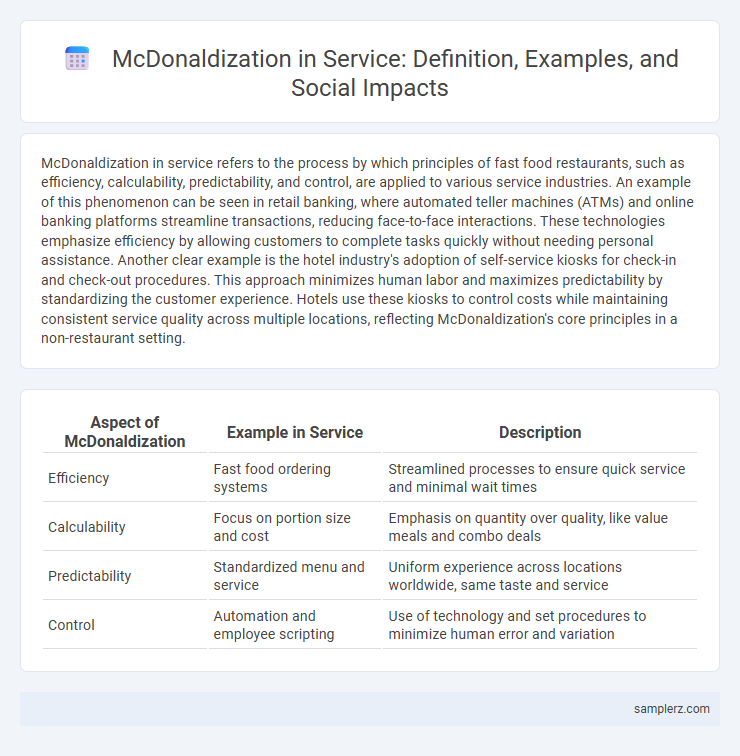McDonaldization in service refers to the process by which principles of fast food restaurants, such as efficiency, calculability, predictability, and control, are applied to various service industries. An example of this phenomenon can be seen in retail banking, where automated teller machines (ATMs) and online banking platforms streamline transactions, reducing face-to-face interactions. These technologies emphasize efficiency by allowing customers to complete tasks quickly without needing personal assistance. Another clear example is the hotel industry's adoption of self-service kiosks for check-in and check-out procedures. This approach minimizes human labor and maximizes predictability by standardizing the customer experience. Hotels use these kiosks to control costs while maintaining consistent service quality across multiple locations, reflecting McDonaldization's core principles in a non-restaurant setting.
Table of Comparison
| Aspect of McDonaldization | Example in Service | Description |
|---|---|---|
| Efficiency | Fast food ordering systems | Streamlined processes to ensure quick service and minimal wait times |
| Calculability | Focus on portion size and cost | Emphasis on quantity over quality, like value meals and combo deals |
| Predictability | Standardized menu and service | Uniform experience across locations worldwide, same taste and service |
| Control | Automation and employee scripting | Use of technology and set procedures to minimize human error and variation |
Efficiency in Fast Food: Streamlined Ordering Processes
Fast food chains such as McDonald's exemplify McDonaldization through highly efficient, streamlined ordering processes that minimize customer wait times and maximize service speed. Self-service kiosks and mobile app ordering reduce human interaction, accelerating order placement and accuracy. These innovations enhance operational efficiency by standardizing and simplifying transactions, reflecting the principles of McDonaldization in social service settings.
Predictability: Standardized Menus and Uniform Service
McDonaldization in service emphasizes predictability through standardized menus, ensuring customers receive the same food items regardless of location. Uniform service protocols, such as consistent preparation methods and employee behavior standards, reinforce this reliability. This approach minimizes uncertainty and enhances customer satisfaction by delivering a familiar experience worldwide.
Calculability: Emphasis on Quantity over Quality
McDonaldization in service emphasizes calculability by prioritizing speed and volume of service rather than product quality, as seen in fast-food chains like McDonald's where customers focus on the number of items served quickly. This approach measures success through quantifiable metrics such as the number of burgers sold per hour instead of culinary excellence. The emphasis on quantity over quality often leads to standardized, mass-produced services that sacrifice uniqueness and customer experience for efficiency.
Control through Non-Human Technology in Service
McDonaldization in service emphasizes control through non-human technology by implementing automated ordering kiosks that streamline customer interactions and reduce human labor. This technological control enhances efficiency and predictability by minimizing errors and standardizing service delivery. Such systems ensure consistent service quality while limiting employee discretion and customer customization.
Automation and Self-Service Kiosks in Customer Experience
Automation and self-service kiosks at McDonald's streamline the customer experience by reducing wait times and minimizing human error. These technologies enable personalized ordering through touchscreen interfaces, enhancing order accuracy and operational efficiency. The integration of automated systems exemplifies McDonaldization's focus on predictability, calculability, and control in fast-food service delivery.
Homogenization of Global Dining Experiences
McDonaldization manifests in the homogenization of global dining experiences by standardizing menus, service protocols, and restaurant layouts across diverse cultures, resulting in a consistent and predictable customer experience worldwide. This uniformity reduces cultural culinary diversity as local eateries adopt McDonald's fast-food model to meet global consumer expectations for efficiency, calculability, and uniformity. As a result, the distinctiveness of regional dining traditions diminishes, replaced by a familiar, mass-produced fast-food environment recognizable from New York to Tokyo.
Training Employees for Uniform Interactions
McDonaldization in service is exemplified by standardized employee training programs that ensure uniform interactions across all locations, emphasizing efficiency, predictability, and control. This approach reduces variability by teaching staff scripted responses and standardized procedures, enhancing consistent customer experiences. Such training models minimize personal discretion, reinforcing uniformity and operational consistency in fast-food and retail sectors.
Deskilling of Labor in Service Environments
McDonaldization in service environments leads to significant deskilling of labor by breaking down complex tasks into simple, repetitive actions that require minimal training. Employees often follow standardized procedures, which reduces the need for specialized skills or autonomy. This process increases efficiency but limits worker creativity and job satisfaction in sectors like fast food and retail.
Customer Expectations and the "McDonaldized" Mindset
Customer expectations in McDonaldized service settings emphasize speed, efficiency, and predictability, demanding uniform experiences regardless of location. The "McDonaldized" mindset encourages consumers to value convenience and standardized products over personalized service or unique interactions. This shift drives businesses to prioritize streamlined processes and measurable outputs, often at the expense of creativity and individual customer needs.
Impact of Rationalization on Personal Service Encounters
McDonaldization in service leads to standardized routines that prioritize efficiency and predictability, often reducing personal interactions to scripted exchanges. This rationalization impacts service encounters by limiting employees' ability to tailor experiences to individual customer needs, resulting in a more impersonal atmosphere. The emphasis on uniformity and control in fast-food chains exemplifies how personal service is transformed into a mechanical process, affecting customer satisfaction and employee autonomy.

example of McDonaldization in service Infographic
 samplerz.com
samplerz.com